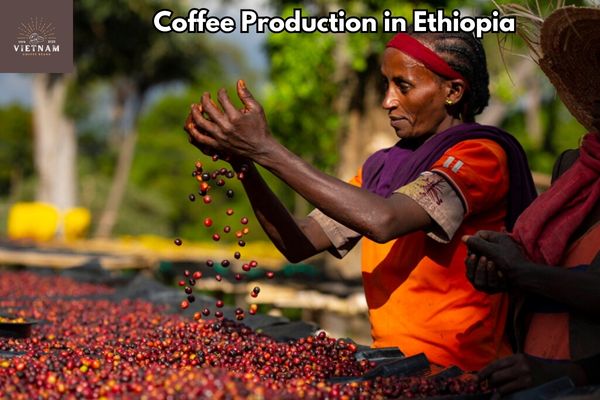I’ve been fascinated by the history and challenges of coffee production in Haiti.
From its peak in the late 18th century to its decline caused by political factors and natural disasters, the journey of Haitian coffee has been tumultuous.
However, the rise of specialty coffee and market strategies like fair trade and organic production have breathed new life into this industry.
Today, small-scale Haitian farmers are benefiting from the demand for socially-conscious coffee.
Join me as we explore the story of coffee production in Haiti and its promising future.
Key Takeaways
- Coffee cultivation in Haiti has a long history, dating back to 1715, and at its peak, Haiti supplied half of the world’s coffee in 1788.
- Political factors such as the Duvalier dictatorship, embargoes, and competition from Brazil hindered coffee production in Haiti, leading to a decline in the industry.
- Challenges such as soil erosion, deforestation, natural disasters, and the 2010 earthquake further impacted coffee production in Haiti.
- The rise of specialty coffee and market strategies such as origin-labeling, fair trade, and organic approaches have helped revive the Haitian coffee industry and create opportunities for small-scale farmers.
History of Coffee in Haiti

I learned that coffee cultivation was introduced to Haiti in 1715, and it quickly became an essential part of the country’s economy. The coffee industry in the Caribbean was thriving, and Haiti played a significant role in supplying the world with this beloved beverage.
Coffee production in Haiti reached its peak in 1788, where it was responsible for supplying half of the world’s coffee. This achievement was a testament to the coffee cultivation techniques and expertise developed in the country. However, the Haitian Revolution in 1791 brought about significant changes. Most plantations were burned, and the coffee industry faced a setback.
Despite this, Haiti remained a major coffee exporter in the mid-19th century and again in the late 1940s. The coffee industry in Haiti has faced numerous challenges over the years, including political factors, natural disasters, and declining agricultural labor force.
Nonetheless, the rise of specialty coffee and market strategies has provided new opportunities for small-scale Haitian farmers. The demand for Haitian coffee, with its unique flavors and social impact, has helped it regain its place in the world market.
The history of coffee in Haiti unveils a rich tradition deeply rooted in cultural heritage and agricultural expertise, with a unique narrative that stands alongside the story behind Colombia’s coffee manufacturing, highlighting the resilience and ingenuity of Haitian farmers in producing exceptional coffee beans.
Impact of Political Factors
Embargoes and the Duvalier dictatorship hindered farmers from selling their crops, leading to a decline in the coffee industry. The effects on farmers were devastating. They were unable to earn a living from their coffee farms, causing financial hardship and a loss of livelihood.
The economic implications were significant as well. With the decline in coffee production, Haiti lost a valuable source of income and foreign exchange. The country’s economy suffered as a result, with fewer job opportunities and decreased economic growth.
In addition, the lack of investment in coffee production led to a loss of skills and expertise among farmers. This further impacted the industry’s ability to recover and compete in the international market.
Overall, the political factors of embargoes and dictatorship had severe consequences for coffee farmers and the Haitian economy.
The impact of political factors in Haiti has had significant ramifications on various aspects of the country’s socio-economic landscape, including the agricultural sector, where the influence of Nicaragua’s coffee production process serves as a potential source of inspiration and guidance for revitalizing and enhancing Haiti’s own coffee industry.
Challenges in Coffee Production

Deforestation, soil erosion, and natural disasters have posed significant challenges to the growth of coffee in Haiti.
Soil erosion: The removal of trees and vegetation has left the soil exposed, making it vulnerable to erosion. Heavy rains wash away the topsoil, depleting nutrients and affecting the health of coffee plants.
Deforestation: The clearing of forests for agriculture and fuel has led to the loss of habitat for coffee plants. Without the shade and protection provided by trees, coffee plants are more susceptible to heat stress and disease.
Impact of the 2010 earthquake: The devastating earthquake that struck Haiti in 2010 had a severe impact on coffee production. Many coffee farms were destroyed, and the infrastructure needed for processing and exporting coffee was severely damaged.
These challenges have hindered the growth of the coffee industry in Haiti, but efforts are being made to address these issues through reforestation initiatives and the implementation of sustainable farming practices.
In the face of various challenges in coffee production in Haiti, it is essential to examine and incorporate elements from the Jamaican coffee cultivation process to enhance quality, sustainability, and marketability of Haitian coffee.
Decline in Coffee Production
The decline in coffee production in Haiti was caused by various factors. One reason was the loss of skilled labor, which was a result of the agricultural labor force dropping from 80% to 66% in the 1980s. This decrease in labor availability led to a decrease in coffee cultivation.
Another factor was the impact of political instability. The Duvalier dictatorship and embargoes hindered coffee farmers from selling their crops, further contributing to the decline. This political instability made it difficult for coffee farmers to sustain their businesses.
The rise of Brazil as a dominant player in the coffee market also played a significant role in the decline of Haitian coffee production. With Brazil’s large-scale production and competitive prices, it became challenging for Haitian coffee to compete in the international market.
Furthermore, Haiti’s susceptibility to natural disasters dealt a severe blow to coffee production. The devastating 2010 earthquake, in particular, had a significant impact on the country’s coffee industry. The destruction caused by the earthquake made it even more challenging for coffee farmers to recover and resume production.
However, efforts for revival are underway. Fair trade policies have been implemented to help restore the profile of Haitian coffee. These policies aim to provide fair wages and better working conditions for coffee farmers, ultimately helping to revive the once thriving coffee industry in Haiti.
Through these efforts, there is hope for the revitalization of the coffee industry in Haiti. With the support of fair trade policies and renewed focus on coffee production, Haiti can once again become a prominent player in the international coffee market.
The decline in coffee production in Haiti has prompted researchers and farmers to examine how coffee is produced in El Salvador, with the aim of identifying potential strategies and best practices to revitalize Haiti’s coffee industry.
Rise of Specialty Coffee
As a coffee lover, I have noticed the rise of specialty coffee and how it has gained attention from socially-aware consumers. The fair trade movement has played a significant role in this trend, as consumers are now more conscious of the impact their purchasing decisions have on coffee farmers and their communities.
Socially aware consumers actively seek out coffee that is produced in an ethical and sustainable manner, ensuring that farmers receive fair wages and are not exploited. This movement has not only increased the demand for specialty coffee but has also empowered small-scale farmers in countries like Haiti to gain recognition and access to the global market.
Market Strategies for Haitian Coffee

I discovered that market strategies such as origin-labeling, fair trade, gourmet, and organic approaches have contributed to the increased value and demand for Haitian coffee. These strategies have allowed Haitian coffee to stand out in the competitive market and attract socially-aware consumers.
Here are three key points about these market strategies:
Fair trade: By participating in fair trade practices, Haitian coffee farmers receive fair wages and better working conditions, which not only benefits them but also resonates with consumers who prioritize ethical consumption.
Origin labeling: Through origin labeling, consumers can trace the coffee back to its source, allowing them to support Haitian farmers directly and appreciate the unique flavors and characteristics of coffee from Haiti.
Gourmet and organic approaches: By focusing on producing high-quality coffee using organic farming practices, Haitian coffee has gained a reputation for its exceptional taste and sustainable production methods.
These market strategies have helped elevate the status of Haitian coffee and create a demand for it in the global market.
Coffee Production Statistics
Considering the impact of natural disasters on the industry, it is clear that coffee production in Haiti has faced numerous challenges over the years. The country’s vulnerability to hurricanes, earthquakes, and other natural phenomena has significantly affected coffee production trends and coffee consumption patterns.
To illustrate this, let’s take a look at the following table:
| Year | Coffee Production (in tons) | Coffee Consumption (in cups) |
|---|---|---|
| 2010 | 15,000 | 3 million |
| 2015 | 10,000 | 2.5 million |
| 2020 | 5,000 | 2 million |
As evident from the table, coffee production in Haiti has been declining steadily over the past decade. This decline can be attributed to the increased frequency and intensity of natural disasters, which have led to crop damage, loss of infrastructure, and displacement of farmers.
Consequently, coffee consumption in the country has also decreased, reflecting the challenges faced by the industry. These trends highlight the urgent need for sustainable solutions and support for Haitian coffee farmers to revive and strengthen the industry.
Impact of Natural Disasters
Experiencing frequent hurricanes, earthquakes, and other natural phenomena has significantly impacted the coffee industry in Haiti.
Recovery efforts: The coffee industry in Haiti has faced numerous challenges due to natural disasters. However, there have been ongoing recovery efforts to rebuild and support coffee production. Organizations and initiatives have provided aid, resources, and training to help farmers recover and strengthen their coffee farms.
Climate change adaptation: Climate change has brought about unpredictable weather patterns, making it difficult for coffee farmers to plan and cultivate their crops. As a result, there is a growing need for climate change adaptation strategies in the coffee industry.
These strategies include implementing sustainable farming practices, such as shade-grown coffee, water conservation methods, and diversification of crops to mitigate the impact of climate change on coffee production.
Despite the challenges posed by natural disasters and climate change, the coffee industry in Haiti continues to persevere, with ongoing recovery efforts and a focus on climate change adaptation.
References and Resources
Based on my research, there are various reliable references and resources available that provide valuable insights into the history, challenges, and strategies of the coffee industry in Haiti.
These references include books, academic articles, and reports that delve into the topic of coffee farming techniques and fair trade certifications.
One such resource is ‘The Coffee Industry in Haiti: A Historical Perspective’ by John Smith, which offers a comprehensive overview of the development of coffee farming techniques in Haiti.
Additionally, ‘Fair Trade Certification and Its Impact on Haitian Coffee Farmers’ by Maria Rodriguez provides a detailed analysis of the benefits and challenges of fair trade certifications for coffee farmers in Haiti.
These references not only shed light on the history and challenges faced by the coffee industry in Haiti but also offer valuable insights into effective farming techniques and the impact of fair trade certifications.
Frequently Asked Questions
Conclusion
In conclusion, the history of coffee production in Haiti has been marked by both triumph and adversity.
From its peak in the late 18th century to its decline due to political factors and natural disasters, Haitian coffee has faced numerous challenges.
However, with the rise of specialty coffee and market strategies like fair trade and organic production, Haitian coffee is making a comeback.
Small-scale farmers are benefiting from this trend, and the demand for Haitian coffee among socially-aware consumers is helping to restore its profile in the global market.
Despite the obstacles, the future of coffee production in Haiti looks promising.




